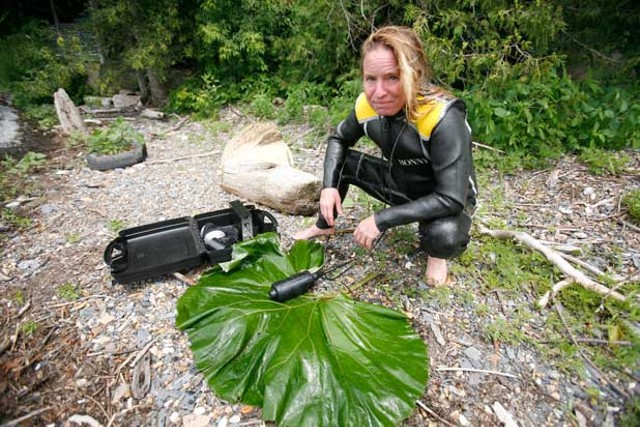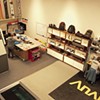Published July 15, 2009 at 6:17 a.m.
Elizabeth von Muggenthaler knows there’s some creature living in Lake Champlain. She’s heard it, and she has the audio recording to prove it. She can’t tell you what it is she heard, but she can tell you what it’s not.
“We know it’s not a beaver, an otter, a deer or a moose,” von Muggenthaler says. “It’s not a sturgeon or a turtle, and it’s definitely not a zebra mussel. Can you imagine that? And we know it’s not a man-made signal.”
On this point, von Muggenthaler can’t be any more clear. This elusive freshwater being she recorded six years ago uses echolocation that sounds like something between the clicking of a Risso’s dolphin and the chirping of a Beluga whale. That makes sense, since dolphins and whales are the only aquatic animals in the world that use echolocation to communicate, navigate and find food. The clicking von Muggenthaler heard wasn’t made by a boat, a fish-finder or an angler’s reel. It was unequivocally a freshwater mammal, she says, most likely a carnivore about 15 feet long that swims at speeds up to five knots and has a highly advanced brain. And it’s not a monster.
Let’s get something straight: Von Muggenthaler isn’t interested in “Champ,” the beast of Lake Champlain lore. She has no tolerance for the legends that have swirled over the years of a water-dwelling reptile/whale/dinosaur. She’s a serious scientist — a bioacoustician who studies animal communication and cognition — and serious scientists don’t trade in monsters or other figments of fanciful imaginations.
Over the next three years, von Muggenthaler and her colleagues, Bill Dranginis, a senior science technologist for Northrup Grumman, and Mike Frizzell, a lab coordinator and engineering technician with the University of Maryland department of chemical engineering and biotechnology, plan to study Lake Champlain to determine just what it was she heard and recorded six years ago. Using the most advanced audio and video recording technology available, the crew hopes to document this animal and finally solve the mystery of what lies beneath the water’s surface.
Von Muggenthaler, 44, is the female version of the wacky-scientist caricature, minus the bubbling beakers, the white lab coat and the Einstein hair. Her ice-blue eyes dart like minnows, her long blond hair is just beyond her control, and she cackles when she makes a joke, which is often. She peppers her speech with “dude,” refers to people as “dear,” and is prone to animated theatrics when emphasizing a point.
On a recent Saturday, von Muggenthaler padded around her mother’s Charlotte home in bare feet wearing bright aquamarine-and-chartreuse plaid pedal-pushers and a brown T-shirt that read “Tree Hugging Dirt Worshipper.” Her wild morning hair was shoved under a red baseball cap. She excused herself as she popped a few pieces of Nicorette gum in her mouth, saying it was either that or she’d have to pull out the tin of chewing tobacco. Her unrefined air was emblematic of someone who spends much of her time conducting field research in farflung locales.
Von Muggenthaler grew up in Charlotte and attended college at Old Dominion University in Norfolk, Va., where she majored in psychology and animal behavior and earned a smattering of minors before moving to Hillsborough, N.C., where she now makes her home. After an internship at NASA Langley Research Center, von Muggenthaler realized there was a dearth of researchers in the field of bioacoustics — the study of natural sound — and determined to fill it in some small way by studying the sounds animals use to communicate.
Her degree from ODU is the only one she has earned, barring an honorary PhD. That’s by design. She reasons: Why spend $250,000 to earn an advanced degree by doing some tenured professor’s work for him when she could be working for herself and making money?
Twenty years ago, von Muggenthaler founded the nonprofit Fauna Communications Research Institute, a scientific organization dedicated to studying animal communication and intelligence with a focus on endangered species. Over the years, she has conducted research on all seven continents, and her organization has received grants from such prestigious organizations as the National Institutes of Health and the National Science Foundation. Von Muggenthaler’s work has been filmed for the National Geographic Channel, the Discovery Channel and PBS’ “Nature” series. Her research has covered the endangered Sumatran rhinoceros, the tiger’s paralysis of its prey, the giraffe’s silent communication and the healing properties of a cat’s purr.
At lectures like the one she recently presented at the Lake Champlain Maritime Museum, von Muggenthaler displays her research as one might exhibit the findings of a science-fair project. Computer printouts are glued to cardboard triptychs and stood up on tables. They’re not the flashy scientific posters made by doctoral students for academic conferences, but they are endearing and accessible to the nonscientist. Presentation isn’t von Muggenthaler’s main concern, she makes clear — results are.
The bioacoustician initially began studying Lake Champlain in 2003 because the Discovery Channel offered her “a lot of money.” She told them she wasn’t going to participate in a “monster quest,” just conduct a legitimate investigation. “That monster stuff, that’s just drama. That’s not science,” she says.
With her late business partner and fellow physicist Dr. Joseph Gregory, von Muggenthaler spent a week aboard a 50-foot cruiser called Casablanca recording sounds in the lake. With military-grade hydrophones, or underwater microphones, placed at various underwater locations, von Muggenthaler and Gregory sat on the deck, wearing headphones, and gazed at four computers, two digital audio recorders, two portable analyzers and two vector sensors as they listened to the sounds coming from the water. In the middle of their week on the lake, they recorded the first of three echolocation noises. Von Muggenthaler knew they had hit paydirt.
“I thought, That sound should not be in the lake. It was clearly echolocation,” she says. “It’s unmistakable. It’s clearly a biological signal. It was just too bizarre.”
The team heard the first example of echolocation in Button Bay. The next day, they recorded another example at Hunter Bay. Days later, their equipment registered another such sound around Thompson’s Point. These locations are significant, von Muggenthaler says, because they correspond not only to alleged Champ sightings, but also to healthy populations of Atlantic salmon. Von Muggenthaler posits that whatever was echolocating in the lake was looking for that salmon.
Each of the recordings presented a unique sound signature, suggesting the presence of three different creatures. Whatever was making them remained invisible, which doesn’t surprise von Muggenthaler. “This thing doesn’t want to have a darn thing to do with humanity,” she says. “It’s elusive.”
Not surprisingly, von Muggenthaler has endured a great deal of criticism for this research. She’s unbothered by claims that the sound she recorded was a boat, a fish or some kind of man-made hoax. She’s confident in her findings, which she claims are indisputable. While she admittedly doesn’t have enough information yet for a credible scientific paper, von Muggenthaler has submitted an abstract of her research, which will be peer-reviewed once she has gathered more information.
That’s the point of her latest Lake Champlain expedition. With financial assistance from a private donor, von Muggenthaler, Dranginis and Frizzell will spend the next three years recording audio and video with monitoring devices that run 24 hours a day, in the hope of collecting more echolocation data.
Recently, the trio scouted power options and locations for their solar-powered equipment. They’ll be using infrared, ultraviolet, thermal imaging, and underwater and above-ground cameras, as well as high-tech audio equipment that detects sound vibration up to 200,000 hertz. By comparison, humans can only perceive sound up to 20,000 hertz.
At the end of the three years of research, von Muggenthaler hopes to be closer to determining the origins of the “bioacoustic anomaly” in Lake Champlain, assuming she can secure more funding. For now, most of her normal grant sources have dried up, and she worries about being able to afford the research once her private donor’s money runs out.
Von Muggenthaler’s official objective is to make a positive identification of the creature that uses echolocation in the lake. Her mission statement reads: “The goal of this research is to detect this animal in a fashion that’s completely noninvasive in an effort to conserve and protect this creature and its beautiful habitat.”
But that’s not her only goal. Von Muggenthaler says she wants people to understand that humans don’t know everything. “Duh,” she says, cackling. While locals indulge the legend of the monster, she points out, few scientists and skeptics consider that there could be a less camera-ready undiscovered animal or a completely new species living in the lake.
According to the International Institute for Species Exploration at Arizona State University, “Millions of species remain unknown or unidentifiable, inaccessible to science and society.” Still, von Muggenthaler is confident that her research can yield answers about just what lives in the water, and perhaps put the idea of a lake monster to rest.
“We know more about space,” she says, “than we do about our own planet.”
Want to learn more?
Elizabeth von Muggenthaler will speak at the Charlotte Senior Center on Wednesday, July 15, at 1 p.m.; and at the ECHO Lake Aquarium and Science Center in Burlington on Thursday, July 16, at 11 a.m. Wednesday’s talk is free and open to the public. Thursday’s talk is free with ECHO admission. Click here for more info on von Muggenthaler’s research.
More By This Author
Speaking of...
-

Overdose-Prevention Site Bill Advances in the Vermont Senate
May 1, 2024 -

Aggressive Behavior, Increased Drug Use at Burlington's Downtown Library Prompt Calls for Help
May 1, 2024 -

Reinvented Deep City Brings Penny Cluse Café's Beloved Brunch Back to Burlington
Apr 30, 2024 -

Burlington’s Blue Cat Steak & Wine Bar Closes After 18 Years
Apr 30, 2024 -

Burlington Budget Deficit Balloons to $13.1 Million
Apr 25, 2024 - More »
Comments
Comments are closed.
From 2014-2020, Seven Days allowed readers to comment on all stories posted on our website. While we've appreciated the suggestions and insights, right now Seven Days is prioritizing our core mission — producing high-quality, responsible local journalism — over moderating online debates between readers.
To criticize, correct or praise our reporting, please send us a letter to the editor or send us a tip. We’ll check it out and report the results.
Online comments may return when we have better tech tools for managing them. Thanks for reading.









































